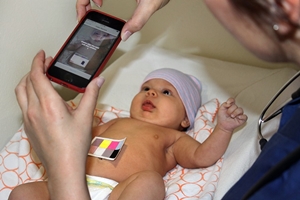27 August 2014. Computer scientists and medical researchers at University of Washington in Seattle are developing a system that lets physicians or parents with a smartphone screen newborn infants for jaundice. The system is described in a paper to be presented on 16 September at the ACM International Joint Conference on Pervasive and Ubiquitous Computing (UbiComp 2014) in Seattle.
Jaundice is a common condition among newborns that results in a yellowish discoloration of the baby’s skin, from an excess of bilirubin, a pigment in the blood. Jaundice occurs in newborns when the liver is not sufficiently developed to rid the blood of bilirubin, a condition not considered immediately dangerous, but if left untreated could lead to severe jaundice or other complications.
The team from the Washington labs of computer scientist Shwetak Patel and pediatrician James Taylor designed the system, called BiliCam, to provide a quick and simple method to screen infants for jaundice. Testing for infant jaundice today requires either analyzing a blood sample for total serum bilirubin (TSB) or a noninvasive transcutaneous bilirubinometer, a specialized measuring device used to screen for jaundice, where according to the authors, each test costs several thouand dollars.
BiliCam requires a photo be taken with a smartphone camera of the baby and a small color calibration card placed on the infant’s body. The image is first adjusted, if required, to account for lighting conditions, and then transmitted to a cloud-based analysis program. There, machine-learning algorithms perform the analysis and return a report to the sending smartphone within minutes.
The researchers tested BiliCam with 100 newborns at two sites in Seattle, 2 to 5 days after birth, where parents allowed their babies to be photographed and analyzed with BiliCam as well as be given the current TSB blood test. The results show a high correlation — o.85, where 1.00 is perfect 1-to-1 correlation — between the BiliCam and the TSB test. That level of correlation, say the authors, is similar to the correlation between TSB and the transcutaneous bilirubinometer used for screeening.
The researchers plan to expand testing to 1,000 newborns, including babies with darker skin pigments to make the system equally usable for all ethnic groups. The researchers filed for patents on the technology and expect to have a submission for approval within 2 years to the U.S. Food and Drug Administration .
Read more:
- FDA Approves AFib Monitor Algorithm for Mobile Devices
- Graphene Sensor Designed for Wearable Disease Detection
- Chip Device Developed to Quickly Test for Type 1 Diabetes
- Mobile App/Sensor Designed to Help Parents Control Stress
- Project Underway to Enable Mobile Health Data Collection
* * *


 RSS - Posts
RSS - Posts
You must be logged in to post a comment.